Resistance bands are a game-changer for glute workouts. These portable, affordable tools create constant tension throughout each movement, activating muscles more effectively than bodyweight exercises alone. In this guide, we’ll walk through five powerful band moves to get toned glutes, along with recommendations for the best resistance bands to maximize your results. Whether you’re working out at home or traveling, these exercises will help you build stronger, more defined glutes with minimal equipment.
Why Resistance Bands Are Perfect for Glute Training
Resistance bands create constant tension throughout your exercises, forcing your muscles to work harder than with bodyweight alone. For glute training specifically, bands are exceptional because they:
- Activate glute muscles more effectively through added resistance
- Create tension in positions where gravity isn’t providing resistance
- Allow for progressive overload as you advance to stronger bands
- Improve mind-muscle connection for better activation
- Are portable, affordable, and versatile for any fitness level
Many people struggle with “quad dominance” during lower body exercises, where the quadriceps take over and the glutes remain underutilized. Resistance bands help correct this imbalance by specifically targeting and activating the glute muscles throughout each movement.
Move 1: Banded Glute Bridge
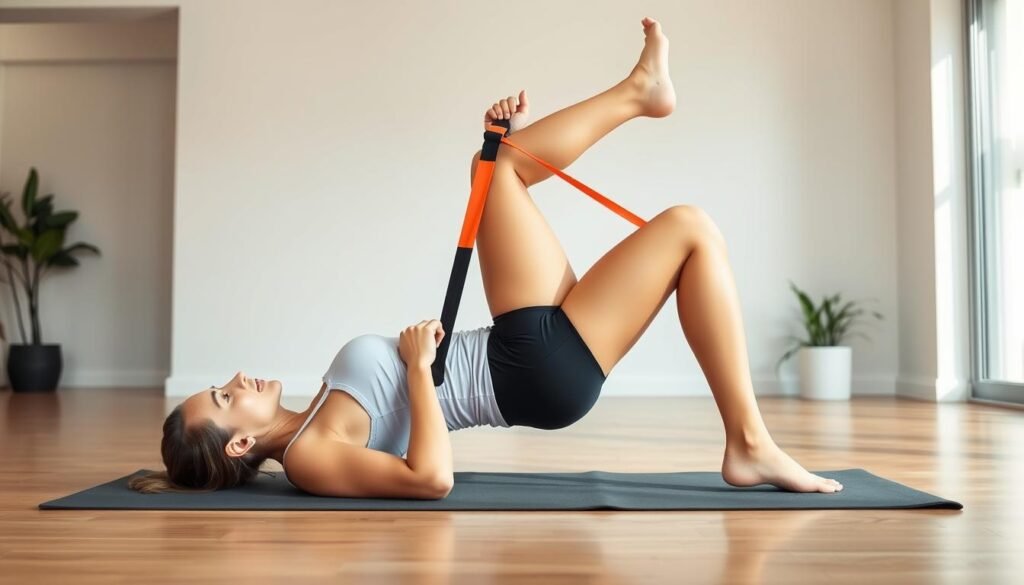
How to Perform:
- Place a resistance band just above your knees
- Lie on your back with knees bent and feet flat on the floor, hip-width apart
- Press your heels into the ground and lift your hips toward the ceiling
- At the top position, push your knees outward against the band
- Squeeze your glutes at the top for 2 seconds
- Lower your hips with control and repeat for 15-20 repetitions
The banded glute bridge targets your gluteus maximus (the largest glute muscle) while also engaging your core for stability. The resistance band adds tension to the movement, forcing your gluteus medius and minimus to work harder as you push against the band.
Recommended for Glute Bridges
For effective glute bridges, you need a durable band that won’t roll or snap during the exercise. The Premium Fabric Resistance Bands provide consistent tension and stay in place throughout your workout.
Move 2: Banded Lateral Walks
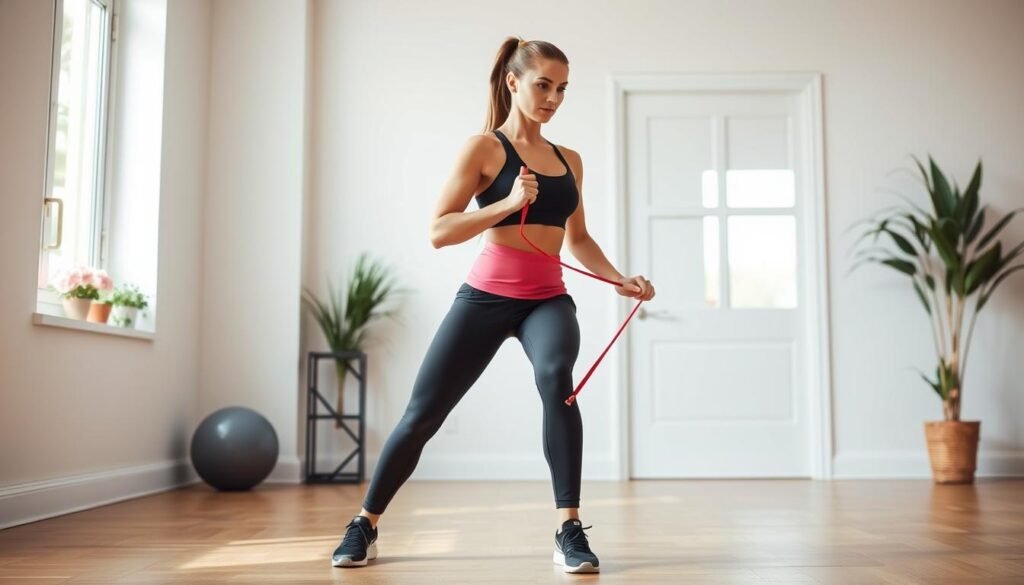
How to Perform:
- Place a resistance band just above your knees
- Stand with feet hip-width apart, knees slightly bent
- Step sideways with your right foot, maintaining tension in the band
- Follow with your left foot, keeping feet hip-width apart
- Take 10-15 steps in one direction, then reverse
- Maintain a slight squat position throughout the movement
Lateral walks primarily target the gluteus medius, which is essential for hip stability and preventing knee injuries. This exercise also engages your core and helps improve balance and coordination. For an added challenge, lower deeper into your squat as you perform the lateral steps.
Perfect for Lateral Movements
The Heavy Duty Resistance Loop Set includes multiple resistance levels, allowing you to progress as your strength improves. The non-slip design prevents rolling during lateral movements.
Move 3: Banded Fire Hydrants
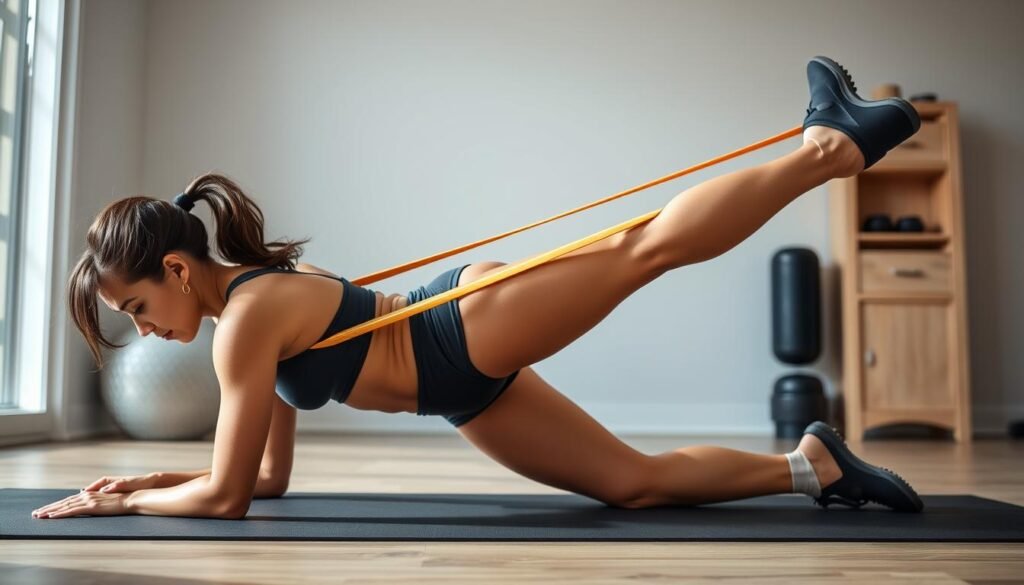
How to Perform:
- Place a resistance band just above your knees
- Start on all fours with wrists under shoulders and knees under hips
- Keeping your knee bent at 90 degrees, lift your right leg out to the side
- Lift until your thigh is parallel to the ground (or as high as comfortable)
- Hold for 1-2 seconds at the top, focusing on the glute contraction
- Lower with control and repeat 15 times before switching sides
Fire hydrants target the gluteus medius and minimus, which are often neglected in traditional workouts. These muscles are crucial for hip stability and proper movement patterns. The resistance band increases the intensity of the exercise, helping to build strength and definition in the side of your glutes.
Ideal for Fire Hydrants
The Fabric Booty Band Set provides comfortable resistance without digging into your skin during floor exercises. The set includes light, medium, and heavy bands to accommodate different fitness levels.
Move 4: Banded Donkey Kicks
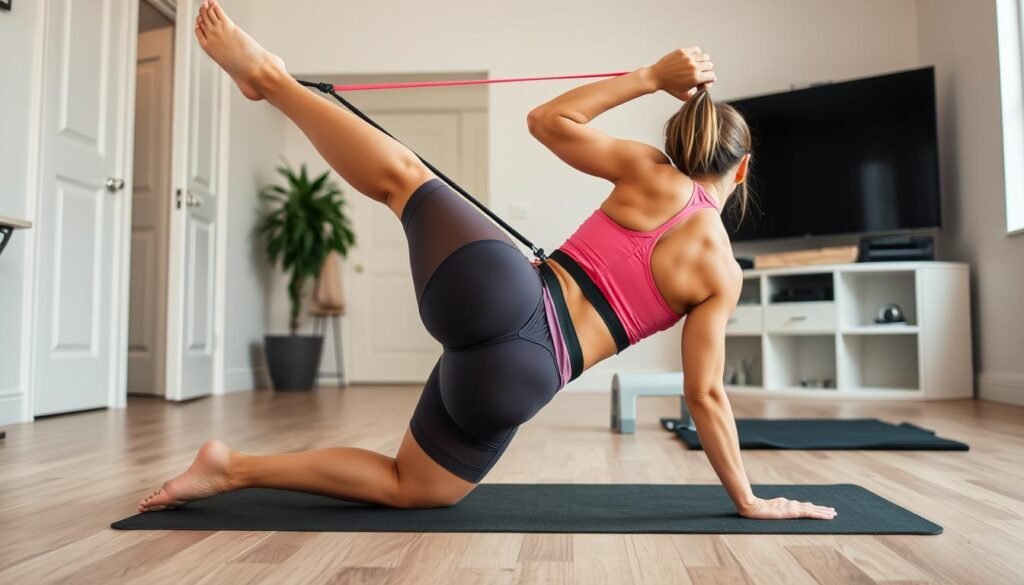
How to Perform:
- Place a resistance band just above your knees
- Start on all fours with wrists under shoulders and knees under hips
- Keeping your right knee bent at 90 degrees, lift your leg up behind you
- Lift until your thigh is parallel to the ground and foot is facing the ceiling
- Squeeze your glute at the top of the movement
- Lower with control and repeat 15 times before switching sides
Donkey kicks primarily target the gluteus maximus, helping to lift and shape the buttocks. The exercise also engages your core muscles for stability. Adding a resistance band increases the intensity throughout the entire range of motion, maximizing glute activation even at the bottom of the movement.
Best for Donkey Kicks
The Premium Hip Circle Band provides consistent tension and stays in place during floor exercises. Its wider design distributes pressure evenly for comfort during longer workout sessions.
Move 5: Banded Squat Pulses
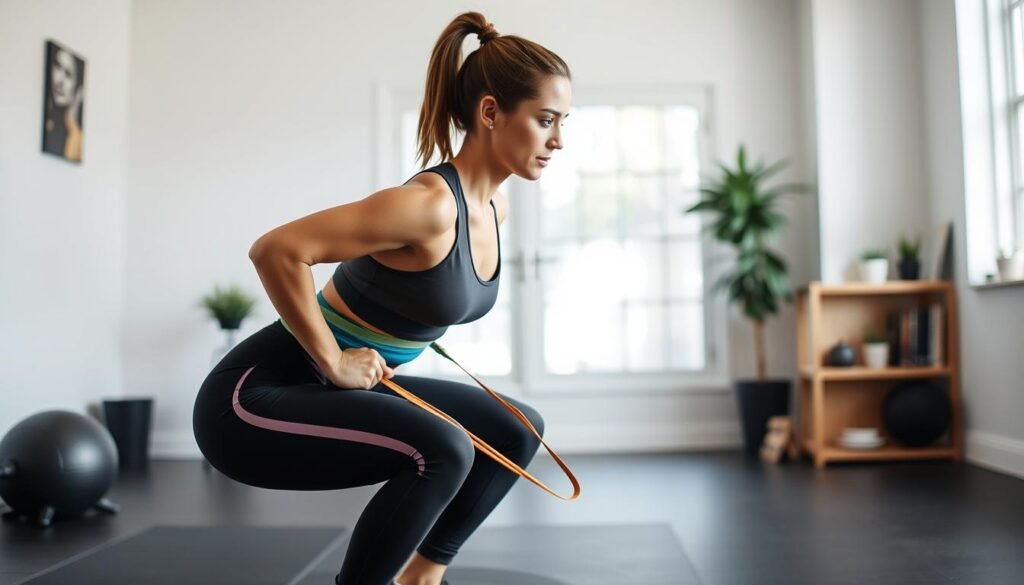
How to Perform:
- Place a resistance band just above your knees
- Stand with feet slightly wider than hip-width apart
- Lower into a squat position, keeping knees pushed out against the band
- From the bottom squat position, pulse up and down 2-3 inches
- Keep tension on the band by actively pushing knees outward
- Perform 20-30 pulses, focusing on glute engagement
Banded squat pulses keep your glutes under constant tension, creating a serious burn that leads to muscle growth. The partial range of motion maintains tension on the muscles throughout the exercise. The resistance band adds an abduction component, ensuring your gluteus medius and minimus are also engaged throughout the movement.
Recommended for Squat Pulses
The Extra Strong Resistance Bands provide the perfect tension for standing exercises like squat pulses. The set includes multiple resistance levels so you can progress as you get stronger.
Complete Glute Band Workout Plan

For best results, combine all five band moves into a complete workout. Perform this routine 2-3 times per week, allowing at least 48 hours between sessions for muscle recovery.
| Exercise | Sets | Reps | Rest |
| Banded Glute Bridge | 3 | 15-20 | 30 seconds |
| Banded Lateral Walks | 3 | 10-15 steps each side | 30 seconds |
| Banded Fire Hydrants | 3 | 15 each leg | 30 seconds |
| Banded Donkey Kicks | 3 | 15 each leg | 30 seconds |
| Banded Squat Pulses | 3 | 20-30 pulses | 30 seconds |
As you progress, increase the resistance by using a stronger band or shortening the band’s length. You can also increase the number of repetitions or add an additional set for more challenge.
Choosing the Right Resistance Bands
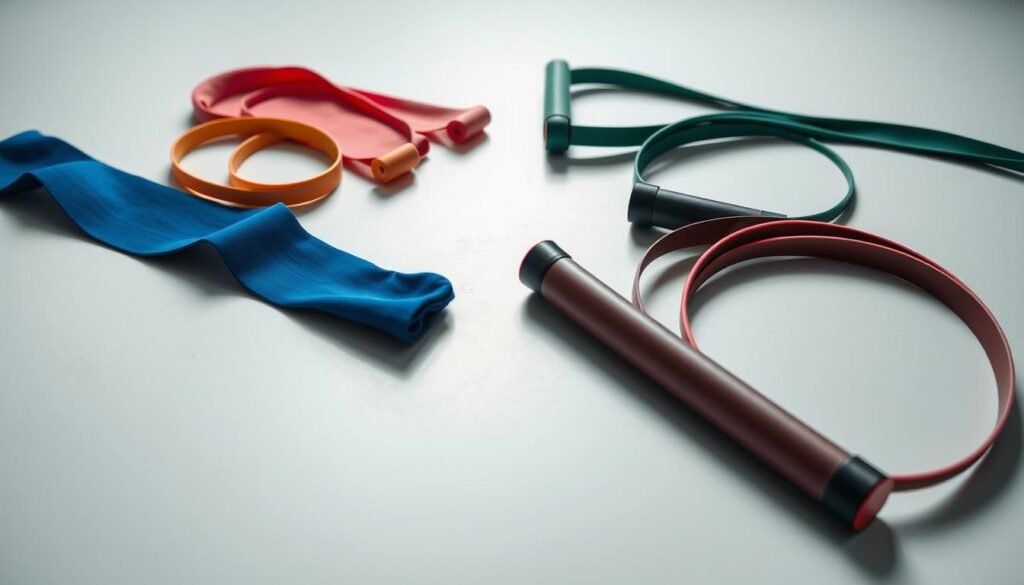
Not all resistance bands are created equal, especially for glute training. Here’s what to look for when selecting bands for your glute workout:
Types of Resistance Bands
Loop Bands (Mini Bands)
These small, looped bands are ideal for glute exercises. They’re typically placed around the thighs or ankles and are perfect for all five exercises in this guide. Look for fabric-covered bands that won’t roll up or pinch your skin during movements.
Tube Bands with Handles
While not ideal for the exercises in this guide, tube bands with handles can be useful for other glute exercises like standing kickbacks. They offer more versatility for a complete home gym setup.
Resistance Levels
Most resistance bands come in sets with different tension levels, typically ranging from light to extra heavy. For glute training:
- Beginners: Start with light to medium resistance
- Intermediate: Use medium to heavy resistance
- Advanced: Use heavy to extra heavy resistance
It’s beneficial to have multiple resistance levels to accommodate different exercises and to progress as you get stronger.
Complete Resistance Band Set
For the best value, consider a complete set of fabric resistance bands with multiple resistance levels. This comprehensive set includes everything you need for all five glute exercises and comes with a convenient carrying bag.
Tips for Maximizing Your Glute Band Workout
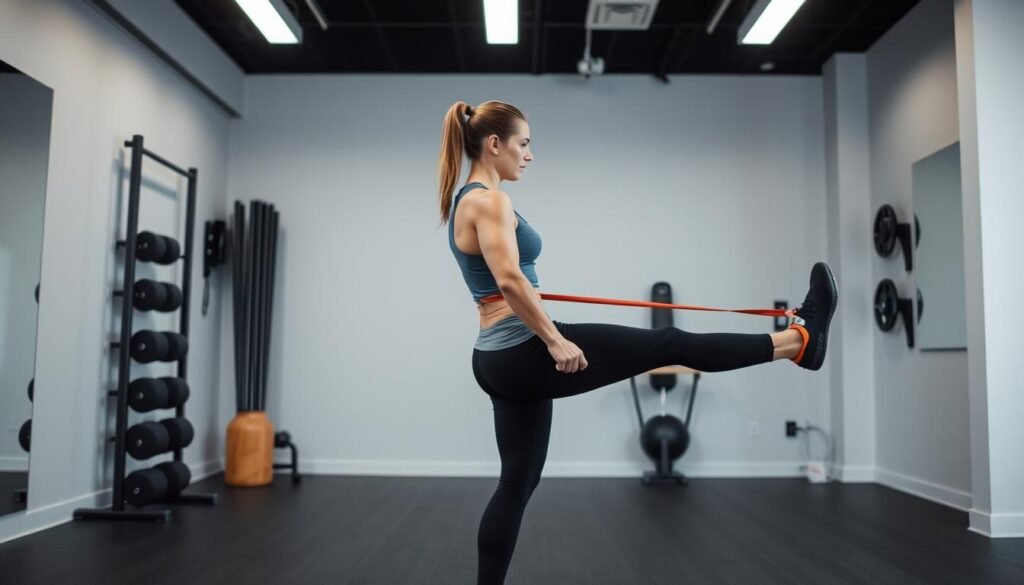
Focus on Mind-Muscle Connection
Consciously focus on contracting your glute muscles during each exercise. This mind-muscle connection increases activation and improves results. Before your workout, try 1-2 minutes of glute activation exercises like clamshells to “wake up” the muscles.
Maintain Proper Form
Quality trumps quantity. Perform each repetition with proper form, focusing on controlled movements rather than rushing through the exercises. Keep your core engaged throughout all movements to protect your lower back.
Progressive Overload
To continue seeing results, gradually increase the difficulty of your workouts. This can be done by using stronger resistance bands, increasing repetitions, adding sets, or decreasing rest periods between exercises.
Consistency is Key
Perform your glute band workout 2-3 times per week consistently for best results. Allow 48 hours between glute-focused workouts for proper recovery and muscle growth.
Frequently Asked Questions
How long will it take to see results from these band exercises?
Most people begin to feel a difference in muscle activation and strength within 2-3 weeks of consistent training. Visible changes in muscle tone typically appear after 4-8 weeks, depending on your starting point, consistency, nutrition, and overall exercise routine.
Can I do these exercises every day?
It’s not recommended to work the same muscle group intensely every day. Your muscles need time to recover and grow stronger. Aim for 2-3 glute-focused workouts per week with at least 48 hours between sessions. On other days, you can focus on different muscle groups or do light cardio.
Will resistance band exercises make my glutes bigger or just toned?
Resistance band exercises can both tone and build your glutes, depending on your approach. For more toning, use lighter bands with higher repetitions (15-20 reps). For more muscle growth, use heavier bands with moderate repetitions (8-12 reps) and ensure you’re consuming adequate protein to support muscle development.
Can I combine these band exercises with other glute workouts?
Absolutely! These band exercises work well as a standalone routine or can complement other glute exercises like squats, lunges, and deadlifts. You can use the band exercises as a warm-up to activate your glutes before heavier lifting or combine them into a comprehensive lower body workout.
Get Started with Your Glute Band Workout Today

Resistance bands are one of the most effective, convenient tools for building stronger, more toned glutes. The five band moves we’ve covered target all areas of your glutes for comprehensive development. By incorporating these exercises into your routine 2-3 times per week, you’ll be on your way to stronger, more defined glutes.
Remember that consistency is key to seeing results. Start with a resistance level that challenges you but allows you to maintain proper form. As you get stronger, progress to heavier bands to continue challenging your muscles.
Ready to Transform Your Glutes?
Get started today with a high-quality resistance band set that includes everything you need for all five exercises. These durable, non-slip bands will help you achieve your glute goals faster and more effectively.


Pingback: 10 Natural Ways to Boost Your Metabolism